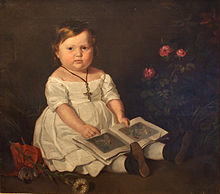Ferdinand von Rayski


Louis Ferdinand von Rayski (born October 23, 1806 in Pegau , † October 23, 1890 in Dresden ) was an important German graphic artist and portrait painter of the 19th century . He is considered a forerunner of the Impressionist painting style in Germany .
Life
The painter of the Saxon and Frankish nobility of the 19th century, Ferdinand von Rayski, was a portraitist and draftsman . Rayski, son of the Saxon officer Johann Karl von Rayski and his wife Sophie Eleonore Henriette, née von Sichartshoff, first went to school at the Dresden Freemasons Institute and then studied at the Dresden Art Academy .
He trained as an officer , but soon left the military. He secured his advancement by visiting his relatives and friends on their estates and castles and painting portraits on these guest trips. Familiar with the manorial lifestyle and aristocratic manners, he was an entertaining companion and good hunter, whose visits were prepared by letters of recommendation. He traveled to Paris , on the way back to Trier . At the end of 1836 he visited August von Manteuffel in Frankfurt am Main , then Würzburg , from there he traveled to Munich in 1837 . After living in Würzburg again in 1838, he moved on to Düsseldorf via Coburg . In December 1839 he returned to Dresden.
Von Rayski mainly created portraits. Many of them are in the Neue Meister gallery in Dresden. His painted stories of the Napoleonic campaign in Russia, in which his father was killed as a Saxon officer in the cold winter of 1812, can be seen today in Nossen Castle. Almost forgotten after his death, Rayski was only rediscovered for the art world by connoisseurs of his almost 700 works after the turn of the century, and then described in several art books. Well-known portraits are still in private hands today. The support group of the Dresden gallery acquired the large-format portrait of Friedrich von Boxberg . He had his cousin Ferdinand von Rayski as guests several times in Zschorna (Meißen district) ; In 1861 the portrait of the host as a hunter was painted with the Zschorna Castle in the background.
Apart from a brief visit to the art academy in Dresden, Rayski was self-taught. Even unmarried, children were his downright favorites. The picture of his five-year-old niece Adelheid von Boxberg is privately owned. The portrait of the young eleven-year-old Haubold von Einsiedel from Lausitz , in a self-confident sitting posture, came into the possession of the Nationalgalerie Berlin as early as 1906 and can be found in various publications on 19th-century painting.
In addition to large-format portraits of his Saxon-Franconian clients, often in uniform or hunting clothes, he was drawn to horses and hunting scenes after his short, unpopular career as an officer. The movement was more important to him than the detail. He captured society women in splendid clothes, but also peasant types. The hunting pictures often included large and small dogs. Not to be forgotten are his rabbit motifs. Ferdinand von Rayski was very witty. A traditional portrait depicts the "Three Snot Noses". With a large tassel he painted "Napoleon from behind" in Großwelka on a plastered garden wall. Like his “wild boars” from the Dresden gallery, many of his works were burned or lost.
Rayski died on his 84th birthday in Dresden. His grave is in the Trinity cemetery there . The city honored him by naming Rayskistraße.

Works (selection)
- Grenadiers in the Snow (1834) and Battle of Borodino (1841) on behalf of the Meissen aristocratic family Schönberg
- Portrait of the mother (around 1840), museum in the Kulturspeicher Würzburg
- Portrait of Chamberlain Julius Graf Zech-Burkersroda (1841), Albertinum , Dresden
- Konrad von Posern (1851), Chemnitz Art Collections
- Hunting break in the Wermsdorf Forest (around 1859), this picture was used by Georg Baselitz in 1969 as a motif for his first picture on his head ( motif reversal )
- Max von Fabrice (1860), Wallraf-Richartz-Museum , Cologne
- Portrait of Friedrich von Boxberg (1861), Galerie Neue Meister , Dresden
- The Driver (1861), Wroclaw National Museum
literature
- Stéphanie Baumewerd: Rayski, (Louis) Ferdinand von . In: Bénédicte Savoy, France Nerlich (ed.): Paris apprenticeship years. A lexicon for training German painters in the French capital . Volume 1: 1793-1843 . De Gruyter, Berlin / Boston 2013, ISBN 978-3-11-029057-8 , pp. 235–237.
- Eva Chrambach: Rayski, Ferdinand v .. In: New German Biography (NDB). Volume 21, Duncker & Humblot, Berlin 2003, ISBN 3-428-11202-4 , p. 222 f. ( Digitized version ).
- Mathias Goeritz: Ferdinand von Rayski and the art of the nineteenth century . Hans von Hugo Verlag, Berlin 1942.
- Rayski, Ferdinand von . In: Friedrich von Boetticher : painter works of the nineteenth century. Contribution to art history . Dresden 1898, Volume 2, p. 368.
- Ernst Sigismund : Ferdinand von Rayski. A biographical attempt (= communications from the Dresden History Association 20). Dresden 1907.
- Ernst Sigismund: Ferdinand von Rayski (1806–1890) (= Dresden artist monographs 2). B. Hartung, Leipzig 1922.
Web links
- Literature by and about Ferdinand von Rayski in the catalog of the German National Library
- Works by Ferdinand von Rayski at Zeno.org .
Individual evidence
- ^ Museum Kunstpalast : Artists from the Düsseldorf School of Painting (selection, as of November 2016, PDF )
- ^ Otto Grautoff : Ferdinand von Rayski . Grote's collection of monographs on art history, Volume IV, Otto Muck, Berlin 1923, p. 38 f. ( Digitized version )
| personal data | |
|---|---|
| SURNAME | Rayski, Ferdinand von |
| ALTERNATIVE NAMES | Rayski, Louis-Ferdinand; Rayski, Louis Ferdinand von (full name) |
| BRIEF DESCRIPTION | German graphic artist and portrait painter |
| DATE OF BIRTH | October 23, 1806 |
| PLACE OF BIRTH | Pegau |
| DATE OF DEATH | October 23, 1890 |
| Place of death | Dresden |
